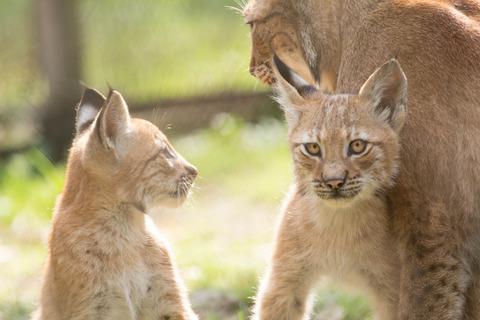Our official English website, www.x-mol.net, welcomes your
feedback! (Note: you will need to create a separate account there.)
Predictors of individual differences in play behavior in Eurasian lynx cubs
Journal of Zoology ( IF 1.9 ) Pub Date : 2020-01-26 , DOI: 10.1111/jzo.12761 A. L. Antonevich 1 , H. G. Rödel 2 , R. Hudson 3 , G. S. Alekseeva 1 , M. N. Erofeeva 1 , S. V. Naidenko 1
Journal of Zoology ( IF 1.9 ) Pub Date : 2020-01-26 , DOI: 10.1111/jzo.12761 A. L. Antonevich 1 , H. G. Rödel 2 , R. Hudson 3 , G. S. Alekseeva 1 , M. N. Erofeeva 1 , S. V. Naidenko 1
Affiliation

|
In many mammals, play is one of the most conspicuous behaviors during early development, but with notable inter‐individual variation even within the same litter. We investigated predictors of such variation in the Eurasian lynx (Lynx lynx), with a focus on potential effects of cubs' early body mass on the frequency of initiating play. We studied 45 cubs from 18 litters, kept in enclosures together with their mother. Observations started when cubs began to leave the natal den (around postnatal day 30) and lasted until weaning (around postnatal day 90). Individual differences in play were consistent over time, across all cubs as well as among littermates. The initiation of different play categories – with siblings, with the mother and solitary play – was positively associated and showed a similar developmental pattern. Cubs' body mass was positively associated with the frequency of play events; heavier cubs initiated play more often than lighter ones. This is consistent with the surplus resource theory, that is, that heavier young might have more energy resources available to allocate to play. Alternatively, lighter cubs may have initiated play less often to avoid asymmetrical rough‐and‐tumble interactions with their heavier siblings. Additionally, we found that offspring from middle‐age mothers initiated play more frequently than offspring from younger or older mothers. As cubs from middle‐age mothers had higher growth rates, this finding is again consistent with the surplus resource theory. Important questions for future research are whether such stable individual differences in play during early development correlate with other behavioral traits and translate into individual differences in behavior in later life.
中文翻译:

欧亚幼崽游戏行为个体差异的预测因子
在许多哺乳动物中,游戏是早期发育过程中最明显的行为之一,但即使在同一窝内,其个体间差异也很明显。我们调查了欧亚(Lynx lynx)中这种变化的预测因子),重点关注幼崽的早期体重对比赛开始频率的潜在影响。我们研究了来自18窝幼崽的45只幼崽,它们与它们的母亲一起被关在了围栏中。观察开始于幼崽开始离开出生窝(出生后第30天左右)并持续到断奶(出生后第90天左右)。随着时间的推移,所有幼崽以及同窝幼仔之间的个体差异都是一致的。与兄弟姐妹,母亲和单人游戏不同的游戏类别的发起是正相关的,并显示出相似的发展模式。小熊的体重与比赛的频率呈正相关。较重的幼崽比较轻的幼崽更多地开始游戏。这与剩余资源理论是一致的,即 较重的年轻人可能会有更多的能量资源可供分配。另外,较轻的幼崽可能会较少地开始游戏,以避免与较重的同胞进行不对称的粗暴互动。此外,我们发现中年母亲的后代比年轻或年长母亲的后代更频繁地玩耍。由于中年母亲的幼崽生长速度较高,这一发现再次与剩余资源理论相一致。未来研究的重要问题是,在早期发展过程中,这种稳定的游戏个体差异是否与其他行为特征相关,并转化为晚年行为的个体差异。较轻的幼崽开始活动的频率可能会降低,以避免与较重的同胞进行不对称的粗暴互动。此外,我们发现中年母亲的后代比年轻或年长母亲的后代更频繁地玩耍。由于来自中年母亲的幼崽具有较高的增长率,这一发现再次与剩余资源理论相一致。未来研究的重要问题是,在早期发展过程中,这种稳定的游戏个体差异是否与其他行为特征相关,并转化为晚年行为的个体差异。较轻的幼崽开始活动的频率可能会降低,以避免与较重的同胞进行不对称的粗暴互动。此外,我们发现,中年母亲的后代比年轻或年长母亲的后代更频繁地玩耍。由于中年母亲的幼崽生长速度较高,这一发现再次与剩余资源理论相一致。未来研究的重要问题是,在早期发展过程中,这种稳定的游戏个体差异是否与其他行为特征相关,并转化为晚年行为的个体差异。这一发现再次与剩余资源理论相一致。未来研究的重要问题是,在早期发展过程中,这种稳定的游戏个体差异是否与其他行为特征相关联,并转化为晚年生活中的个体差异。这一发现再次与剩余资源理论相一致。未来研究的重要问题是,在早期发展过程中,这种稳定的游戏个体差异是否与其他行为特征相关,并转化为晚年行为的个体差异。
更新日期:2020-01-26
中文翻译:

欧亚幼崽游戏行为个体差异的预测因子
在许多哺乳动物中,游戏是早期发育过程中最明显的行为之一,但即使在同一窝内,其个体间差异也很明显。我们调查了欧亚(Lynx lynx)中这种变化的预测因子),重点关注幼崽的早期体重对比赛开始频率的潜在影响。我们研究了来自18窝幼崽的45只幼崽,它们与它们的母亲一起被关在了围栏中。观察开始于幼崽开始离开出生窝(出生后第30天左右)并持续到断奶(出生后第90天左右)。随着时间的推移,所有幼崽以及同窝幼仔之间的个体差异都是一致的。与兄弟姐妹,母亲和单人游戏不同的游戏类别的发起是正相关的,并显示出相似的发展模式。小熊的体重与比赛的频率呈正相关。较重的幼崽比较轻的幼崽更多地开始游戏。这与剩余资源理论是一致的,即 较重的年轻人可能会有更多的能量资源可供分配。另外,较轻的幼崽可能会较少地开始游戏,以避免与较重的同胞进行不对称的粗暴互动。此外,我们发现中年母亲的后代比年轻或年长母亲的后代更频繁地玩耍。由于中年母亲的幼崽生长速度较高,这一发现再次与剩余资源理论相一致。未来研究的重要问题是,在早期发展过程中,这种稳定的游戏个体差异是否与其他行为特征相关,并转化为晚年行为的个体差异。较轻的幼崽开始活动的频率可能会降低,以避免与较重的同胞进行不对称的粗暴互动。此外,我们发现中年母亲的后代比年轻或年长母亲的后代更频繁地玩耍。由于来自中年母亲的幼崽具有较高的增长率,这一发现再次与剩余资源理论相一致。未来研究的重要问题是,在早期发展过程中,这种稳定的游戏个体差异是否与其他行为特征相关,并转化为晚年行为的个体差异。较轻的幼崽开始活动的频率可能会降低,以避免与较重的同胞进行不对称的粗暴互动。此外,我们发现,中年母亲的后代比年轻或年长母亲的后代更频繁地玩耍。由于中年母亲的幼崽生长速度较高,这一发现再次与剩余资源理论相一致。未来研究的重要问题是,在早期发展过程中,这种稳定的游戏个体差异是否与其他行为特征相关,并转化为晚年行为的个体差异。这一发现再次与剩余资源理论相一致。未来研究的重要问题是,在早期发展过程中,这种稳定的游戏个体差异是否与其他行为特征相关联,并转化为晚年生活中的个体差异。这一发现再次与剩余资源理论相一致。未来研究的重要问题是,在早期发展过程中,这种稳定的游戏个体差异是否与其他行为特征相关,并转化为晚年行为的个体差异。











































 京公网安备 11010802027423号
京公网安备 11010802027423号